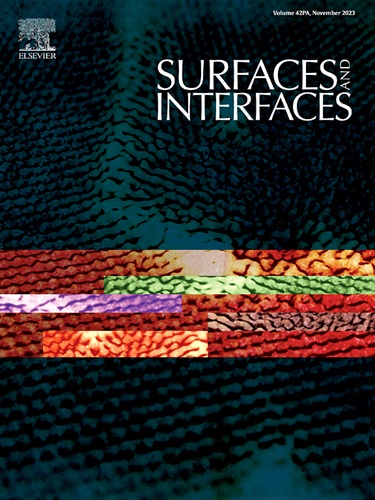Improvement of wear and corrosion resistance of aluminum alloy weld by constructing a laminate microstructure
IF 5.7
2区 材料科学
Q2 CHEMISTRY, PHYSICAL
引用次数: 0
Abstract
Periodic ultrasonic vibration enhances aluminum alloy weld surface properties by constructing a laminate microstructure, significantly improving wear and corrosion resistance. This study examined how periodic ultrasonic vibration influence laminate microstructure development, wear resistance, and corrosion resistance. The main results are as follows: The laminate weld microstructures with different layer widths could be designed by varying the switching-on/off time of the ultrasonic vibrations. The stratification features become less distinct when the switching-on/off time is short, as this leads to a reduced distance between layers. Weld microstructures with obvious delamination characteristics can be obtained when the switching-on/off time is 0.4 s and 0.7 s. Following the application of periodic ultrasonic vibration, a significant increase in both dislocation density within the weld grains and the number of subgrain boundaries was observed. The interfacial density and subgrain structure play a crucial role in determining the wear and corrosion resistance properties of weld. The application of ultrasonic vibration with a switching-on/off time of 0.1 s/0.1 s leads to significant improvements in weld performance, showing a 49.67 % reduction in wear rate and a 52.92 % decrease in corrosion current density compared to the original weld characteristics.

通过构建层状组织提高铝合金焊缝的耐磨性和耐腐蚀性
周期性超声振动通过构建层状微观结构改善铝合金焊缝表面性能,显著提高耐磨性和耐腐蚀性。本研究考察了周期性超声振动对层压板微观结构发展、耐磨性和耐腐蚀性的影响。主要研究结果如下:通过改变超声振动的开启/关闭时间,可以设计出不同层宽的层状焊缝组织;当开关时间较短时,分层特征变得不那么明显,因为这导致层之间的距离缩短。当开关时间为0.4 s和0.7 s时,焊缝组织具有明显的分层特征。应用周期性超声振动后,焊缝晶粒内的位错密度和亚晶界数量均显著增加。界面密度和亚晶组织对焊缝的耐磨损和耐腐蚀性能起着至关重要的作用。在0.1 s/0.1 s的开启/关闭时间下应用超声波振动,焊缝性能得到显著改善,与原始焊缝特性相比,磨损率降低49.67%,腐蚀电流密度降低52.92%。
本文章由计算机程序翻译,如有差异,请以英文原文为准。
求助全文
约1分钟内获得全文
求助全文
来源期刊

Surfaces and Interfaces
Chemistry-General Chemistry
CiteScore
8.50
自引率
6.50%
发文量
753
审稿时长
35 days
期刊介绍:
The aim of the journal is to provide a respectful outlet for ''sound science'' papers in all research areas on surfaces and interfaces. We define sound science papers as papers that describe new and well-executed research, but that do not necessarily provide brand new insights or are merely a description of research results.
Surfaces and Interfaces publishes research papers in all fields of surface science which may not always find the right home on first submission to our Elsevier sister journals (Applied Surface, Surface and Coatings Technology, Thin Solid Films)
 求助内容:
求助内容: 应助结果提醒方式:
应助结果提醒方式:


